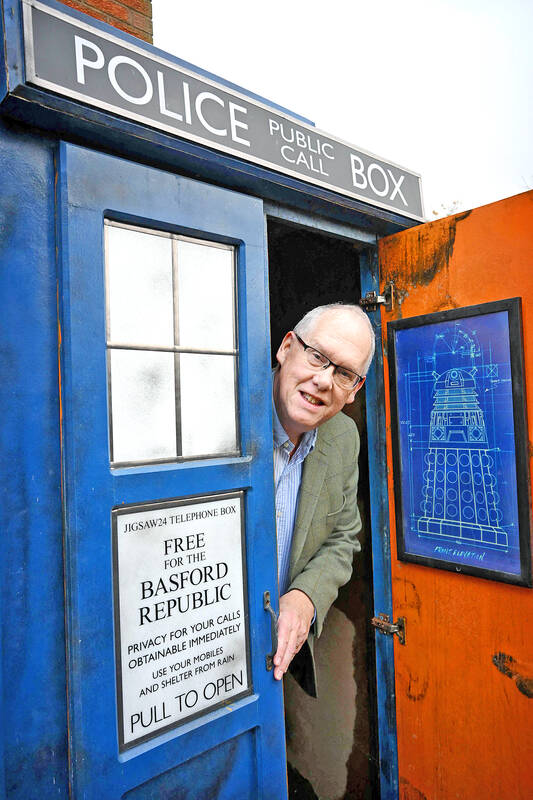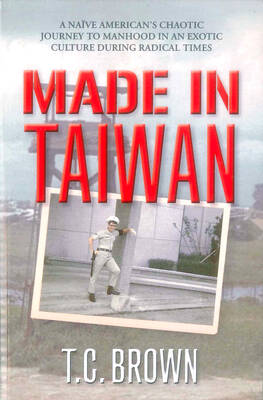Britain celebrates the 60th anniversary of science-fiction series Doctor Who today as fans hail a program that has enthralled generations since it was first broadcast. Six million people watched the first episode when it was aired at teatime on Nov. 23, 1963, following the adventures of “The Doctor,” a fugitive Time Lord with two hearts from the planet Gallifrey. The enduring series — the longest-running of its genre in the world — is expected to release a new season next year
In the beginning, not everyone was immediately won over, particularly by the TARDIS, his hybrid spacecraft/time machine mostly in the form of an old-fashioned British police call box that is bigger on the inside.
“A police box with flashing beacon traveling through interstellar space — what claptrap!” said one viewer surveyed by the BBC.

Photo: AFP
A more prophetic view came from parents who said it promised to be “very entertaining” and accurately predicted their children “would love it.”
Life-long fan Tony Jordan, 64, has a full-sized TARDIS replica in his garden.
He said some of his first memories were of being petrified by foes of the doctor as he watched with his mother as a young boy.
“It was the monsters — the Daleks, the Cybermen, the Ice Warriors — that just really got my imagination,” said Jordan, from Heath Hayes, central England.
Jordan said financial constraints were a big part of Doctor Who’s success.
“When people are under budget pressure it does force them to be more creative than maybe they might have been,” he said “Especially in the early days, they couldn’t just CGI everything because that technology simply didn’t exist so it forced them to come up with something that captures people’s imaginations.”
The anniversary will be marked with three television specials with the first — “Star Beast” — due to go out on the BBC and Disney+ on Saturday.
DALEKS RETURN
The three specials feature Scottish actor David Tennant, who played The Doctor between 2005 and 2010.
One of Doctor Who’s most popular and enduring enemies — the Daleks — are also returning in the form of a one-off 75-minute film.
The new film colorises and weaves together the seven original episodes from 1963/4 that introduced the extraterrestrial race of xenophobic mutants with their chant of “Exterminate! Exterminate!”
The program quickly established itself as a cultural landmark in the UK.
Its longevity was assured by a decision to “regenerate” the lead character when the first Doctor, played by actor William Hartnell, left the show in 1966.
The humanoid Time Lords can cheat death by changing their entire appearance — a cornerstone of the show which has now featured more than a dozen actors in the title role.
“It was born out of production demands but they took the idea and ran with it to reboot the show every few years when they need,” said Jordan.
He recalls being “a little bit confused” at seeing one of the early switches.
“I didn’t know why The Doctor was now a man in a leather jacket rather than a 1960s gentleman character, but I got over that quite quickly,” he said.
GLOBAL APPEAL
Doctor Who’s journey to world-wide popularity began when the US sci-fi community embraced it after the series was bought by PBS.
Fans — of all ages, and from all over the world — now regularly meet at huge arena-sized events to meet their idols and fellow enthusiasts.
The 50th anniversary special episode a decade ago was shown in 94 countries.
Although the BBC shelved Doctor Who in 1989, it was revived in 2005 under the stewardship of screenwriter and producer Russell T Davies.
The show is now a BBC co-production with Disney and the three specials are due to be broadcast on successive Saturdays from this week.
After that, 15th doctor Ncuti Gatwa — the first actor of color to play the part — will take over from Jodie Whittaker, the first woman in the role.
“It seems like it’s going to be bigger than ever,” said Jordan.
But while the new series will undoubtedly be slicker, he said it would remain true to the vision of the early program makers.
“It’s that cliche of children hiding behind the sofa while their parents watch it, it’s an opportunity for people to get together and be swept away by a magical sci-fi adventure,” he said. “That will always be the core of Doctor Who.”

Aug. 25 to Aug. 31 Although Mr. Lin (林) had been married to his Japanese wife for a decade, their union was never legally recognized — and even their daughter was officially deemed illegitimate. During the first half of Japanese rule in Taiwan, only marriages between Japanese men and Taiwanese women were valid, unless the Taiwanese husband formally joined a Japanese household. In 1920, Lin took his frustrations directly to the Ministry of Home Affairs: “Since Japan took possession of Taiwan, we have obeyed the government’s directives and committed ourselves to breaking old Qing-era customs. Yet ... our marriages remain unrecognized,

During the Metal Ages, prior to the arrival of the Dutch and Chinese, a great shift took place in indigenous material culture. Glass and agate beads, introduced after 400BC, completely replaced Taiwanese nephrite (jade) as the ornamental materials of choice, anthropologist Liu Jiun-Yu (劉俊昱) of the University of Washington wrote in a 2023 article. He added of the island’s modern indigenous peoples: “They are the descendants of prehistoric Formosans but have no nephrite-using cultures.” Moderns squint at that dynamic era of trade and cultural change through the mutually supporting lenses of later settler-colonialism and imperial power, which treated the indigenous as

By 1971, heroin and opium use among US troops fighting in Vietnam had reached epidemic proportions, with 42 percent of American servicemen saying they’d tried opioids at least once and around 20 percent claiming some level of addiction, according to the US Department of Defense. Though heroin use by US troops has been little discussed in the context of Taiwan, these and other drugs — produced in part by rogue Chinese Nationalist Party (KMT) armies then in Thailand and Myanmar — also spread to US military bases on the island, where soldiers were often stoned or high. American military policeman

An attempt to promote friendship between Japan and countries in Africa has transformed into a xenophobic row about migration after inaccurate media reports suggested the scheme would lead to a “flood of immigrants.” The controversy erupted after the Japan International Cooperation Agency, or JICA, said this month it had designated four Japanese cities as “Africa hometowns” for partner countries in Africa: Mozambique, Nigeria, Ghana and Tanzania. The program, announced at the end of an international conference on African development in Yokohama, will involve personnel exchanges and events to foster closer ties between the four regional Japanese cities — Imabari, Kisarazu, Sanjo and